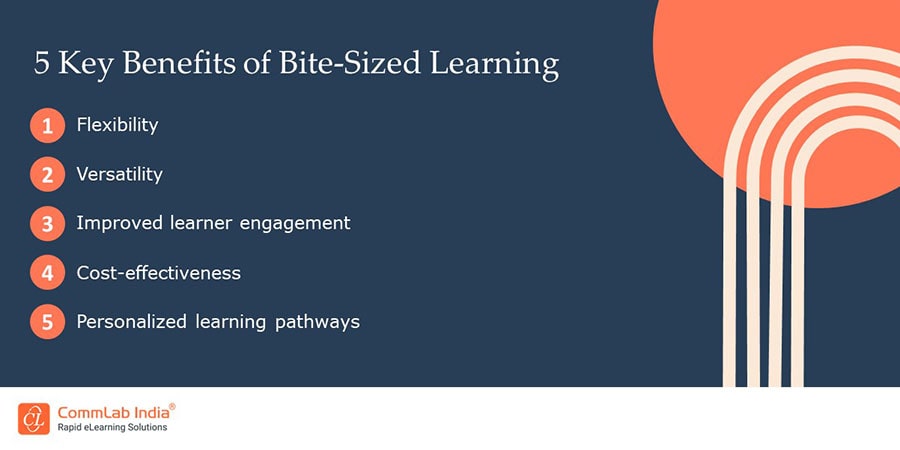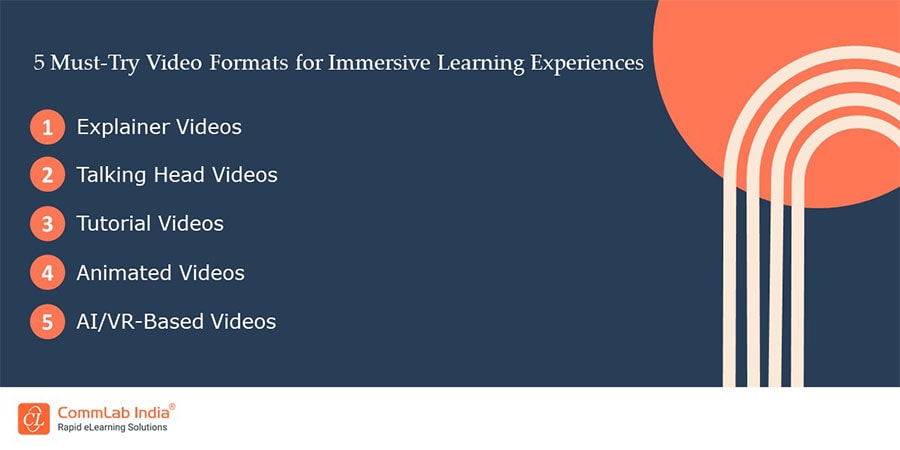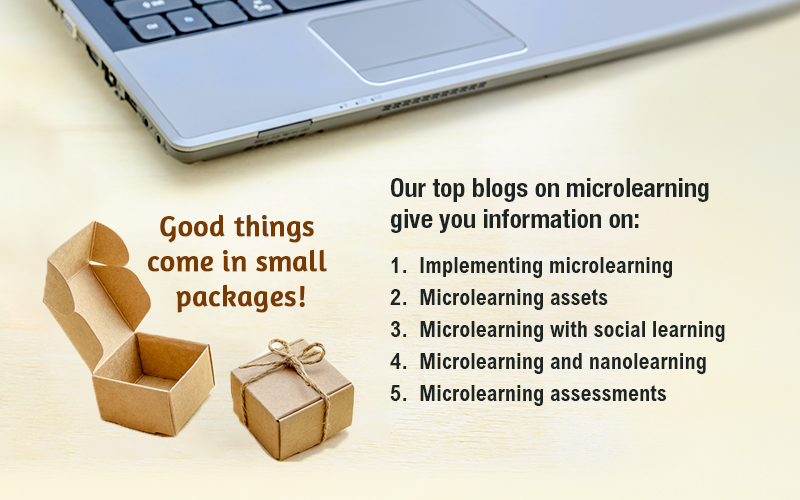How Bite-Sized Learning Modules Can Level Up Your Employee Training
Bite-sized learning is like a power-packed snack - quick, convenient, and easy to grab. Read on to explore how it can amp up your employee training initiatives.

Constant business innovations are becoming a norm in today’s fast-evolving world. Though this is exciting, it might be overwhelming at times. Especially, when it comes to imparting training to your employees to keep them abreast of the new business processes and offerings. Employees today are taking up multiple roles to cater to the increasing business demands. This always keeps them on their toes. However, continuous upskilling and reskilling is a must to keep pace with the rapid advancements in business trends. What’s the solution then? Well, the answer is bite-sized learning modules. Read the blog to understand the world of bite-sized learning and explore how bite-sized learning can help in effective employee training.
Bite-Sized Learning Can Rev Up Your Employee Training
Here are a few popular bite-sized learning formats:
- Videos
- Podcasts
- Infographics
- Social media
- Games and Quizzes
Read on to explore how to leverage them for effective employee training.
First Things First — What is Bite-Sized Learning?
As the name suggests, bite-sized learning is a modern learning approach that delivers information in the form of small snackable content pieces that are easy to consume. Bite-sized learning, also known as microlearning, focuses on breaking the information into small learning nuggets to deliver just-in-time learning. Each learning module covers a single learning objective and is focused on delivering targeted content. Bite-sized learning modules are accessible on any mobile device and allow self-paced learning. This approach allows learning in the flow of work and ensures the dissemination of the required information in the moment of need without overwhelming learners.
→ Download eBook: Microlearning 101
Why is Bite-Sized Learning the Right Choice for Modern Learners
The present-day workforce is a dominant mix of millennials and Gen Zs who have considerably low attention spans. They are the ones who love flexibility and freedom. So, when it comes to training modern learners, bite-sized learning doesn’t fail to play its charm as it matches today’s modern busy lifestyle. This learning approach allows the flexibility to learn on the go. Modern learners don’t mind listening to a podcast or watching a short video to learn something new while commuting or during quick breaks at work.
What are the Key Benefits of Bite-Sized Learning?
Bite-sized learning is refreshing. It makes training enjoyable rather than a required chore. These bite-sized learning nuggets fit into busy work schedules and learners find it convenient to consume at their convenience.

Let’s delve into the key benefits of bite-sized learning that make it a top choice for modern-day learning:
Flexibility
Bite-sized learning modules are multi-browser and multi-device compatible. This allows the flexibility to learn anytime anywhere and on any device of choice. Bite-sized learning modules offer the scope of self-paced learning and learners can go through them during commute, during work breaks, or at home.
Versatility
Bite-sized learning modules are usually designed in a variety of formats such as videos, infographics, or eBooks. It hooks learners, curbs monotony, and ensures better learning.
Improved Learner Engagement
Sitting in front of computers post work to attend training sessions is a daunting task. However, bite-sized learning modules are like a fresh breath of air that delivers information in a crisp and quick shot. Moreover, these learning modules are presented in engaging formats that appeal to learners, simplify understanding, and ensure better retention.
Cost-effectiveness
Bite-sized learning modules can be designed and developed in less time using minimal resources. They are easy to deliver as you do not need any infrastructure or facilitator for content delivery. These learning nuggets can be delivered as standalone courses or can be integrated into other learning formats under the blended learning umbrella, thereby enhancing their utility. You can also edit the content easily in case of small changes in the concepts. This adds to the training ROI and saves your cost.
Personalized learning pathways
Bite-sized learning modules can be handy in crafting personalized learning pathways for your learners. You can update and customize the content according to specific individual learning needs, styles, and preferences and offer an immersive learning experience to the learners.
What are the Popular Bite-Sized Learning Formats?
Bite-sized learning modules can be crafted in multiple formats. Depending on the topic and the learning needs you can choose your format. Let’s look at a few popular formats that can awe your learners and offer enjoyable learning experiences:
Videos
Videos are an all-time favorite. We look for them whether we want to learn a recipe, plan our next trip, or for that matter learn how to use our newly bought electronic gadget. When it comes to employee training, videos are a clever bait. Using videos, you can easily deliver the desired message and rest assured about the learning outcomes. Be it a product demo, walking learners through a process, or explaining the operation of complicated machinery, videos can be an effective tool.

Podcasts
Podcasts are undoubtedly popular in today’s time. You can circulate podcasts from influencers, senior leaders, and industry experts on your social channels or social learning apps. You can plan podcasts around best industry practices, insights on current industry trends, and war stories to keep your learners updated.
Infographics
Infographics are a wonderful way to condense information on a single screen. It is easy for learners to grasp the information presented at a glance and is a fantastic format for just-in-time learning. For instance, your sales reps can quickly skim through the product features and functionalities before a client meeting and feel confident to seal potential deals.
Social Media
Modern learners spend a considerable amount of time on social media. They use the platform not only for entertainment but also for networking and learning new things. No wonder online discussion forums, communities, and social learning apps are becoming widely popular. Why not leverage this opportunity to train your learners? You can create social learning groups where you can share daily tips on various topics. You can also post questions for discussion and encourage learners to exchange ideas and opinions. Such activities facilitate peer-to-peer learning and promote collaboration.
Watch this video to explore ways to foster social learning for the remote workforce.
Games and Quizzes
Who doesn’t love to play games? Learning while having fun not only ensures learner engagement but also retains learning for a longer haul. Interactive videos and game-based microlearning modules are fantastic ways to engage learners with the content. Gaming elements such as points, levels, rewards, and leaderboards motivate learners to actively participate and make learning enjoyable. Quick quizzes are a fantastic way to assess learning after the main training sessions. They are a great tool for refresher training and can be used for quick knowledge checks in the pre-training phase.
It's a Wrap!
Bite-sized learning is like a power-packed snack — quick, convenient, and easy to grab! The concept of bite-sized learning offers a powerful solution for modern employee training needs. By breaking down complex topics into snackable chunks, you can enhance the retention, engagement, and overall effectiveness of your training programs. With microlearning modules, employees can access relevant information conveniently, fitting learning into their busy schedules. Furthermore, the adaptability of this approach allows for personalized learning experiences tailored to individual needs and preferences. As we continue to embrace innovation in the workplace, incorporating bite-sized learning strategies can empower organizations to stay competitive, foster continuous growth, and ultimately, drive success in the ever-evolving landscape of employee development.
Ready to get started with bite-sized learning for training your employees? Here’s an eBook that offers insights on how to fit it in your learning strategy. Grab your copy now!





